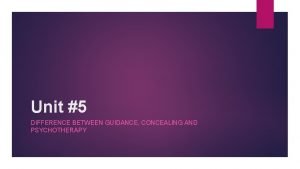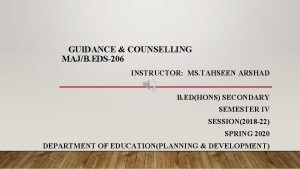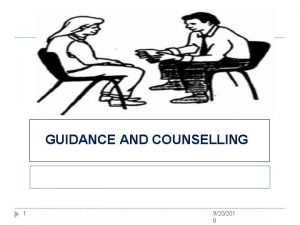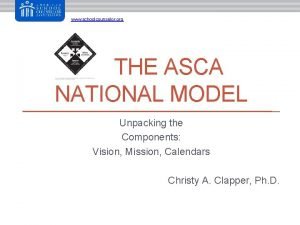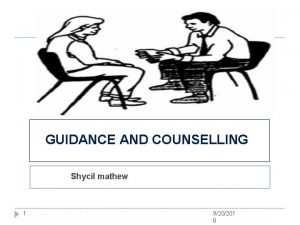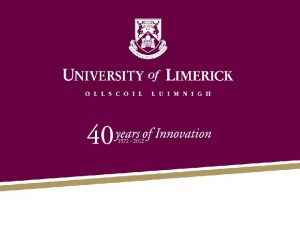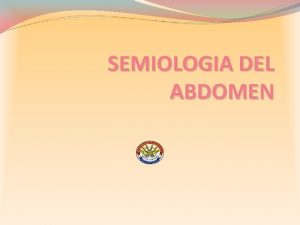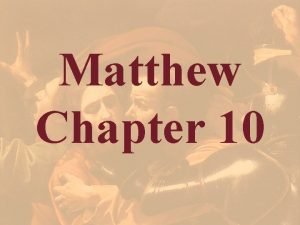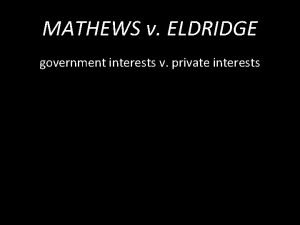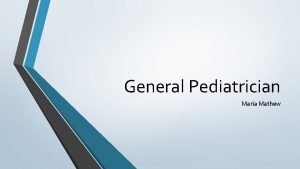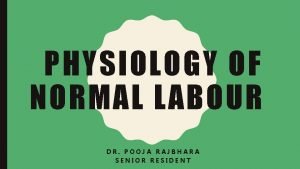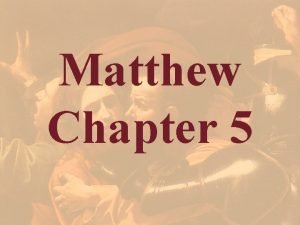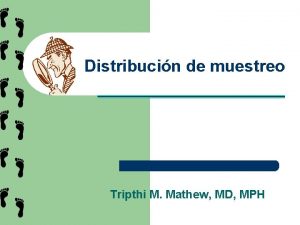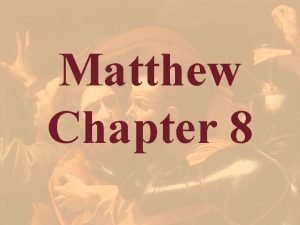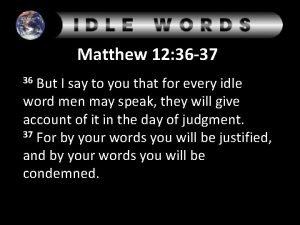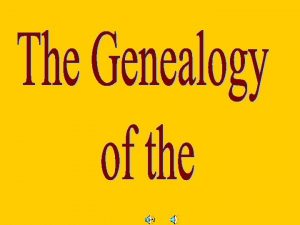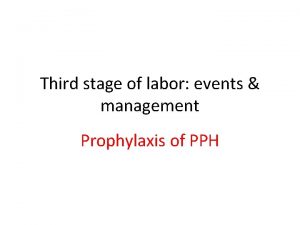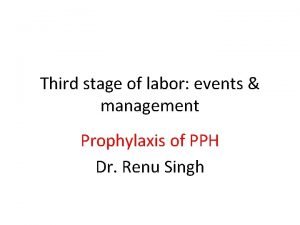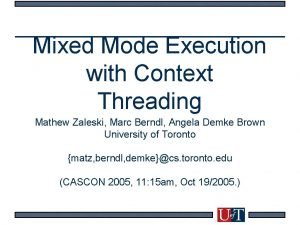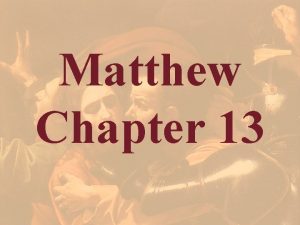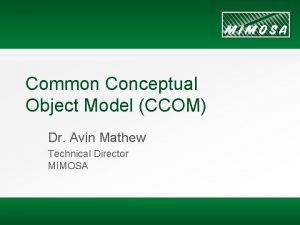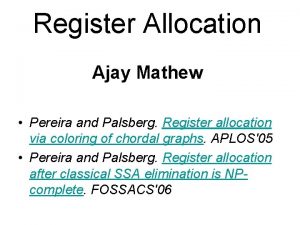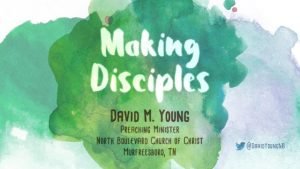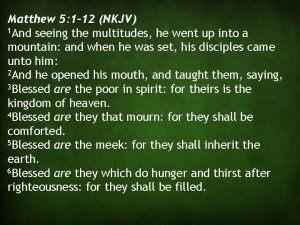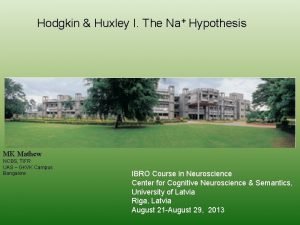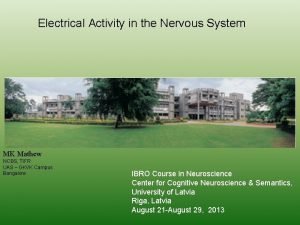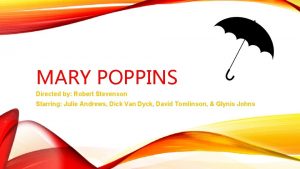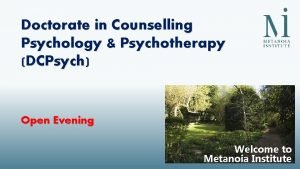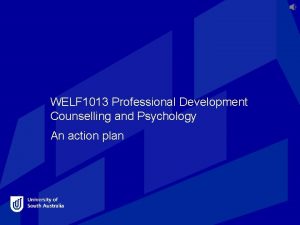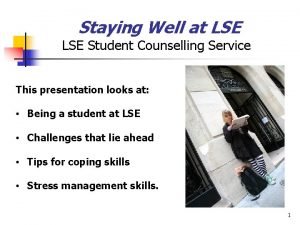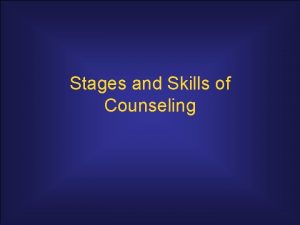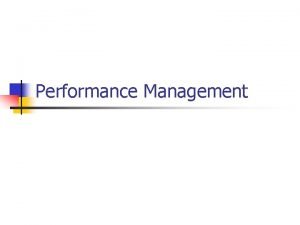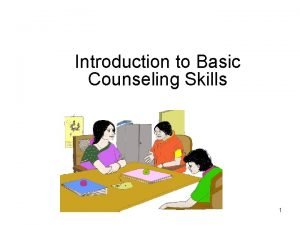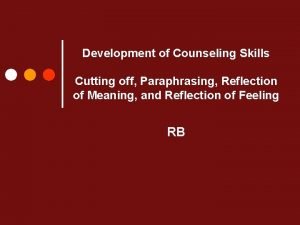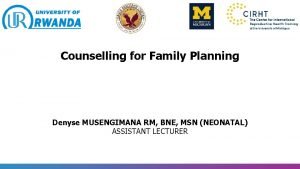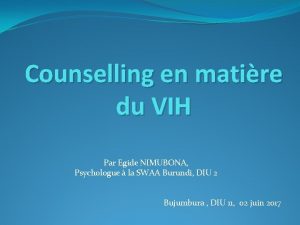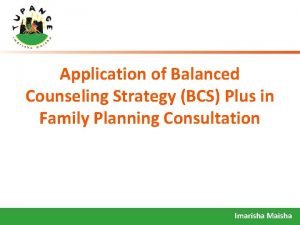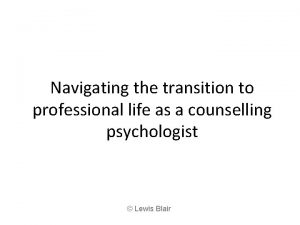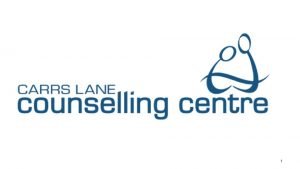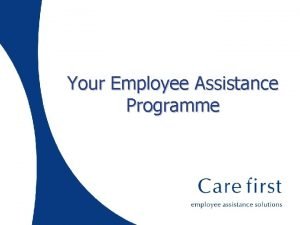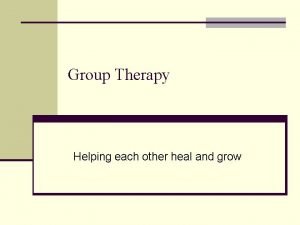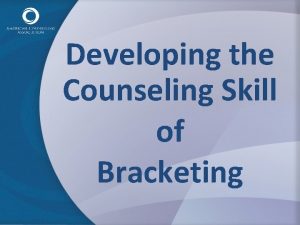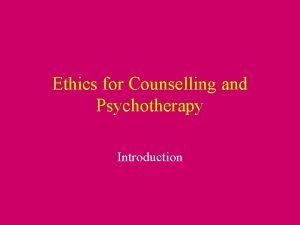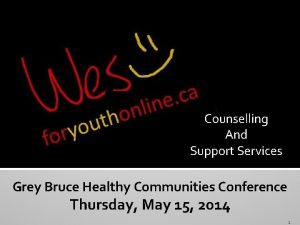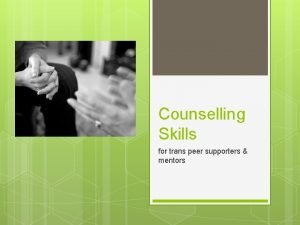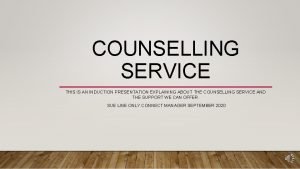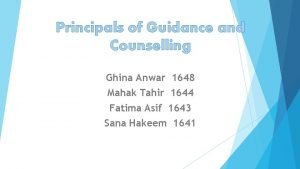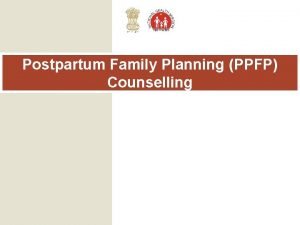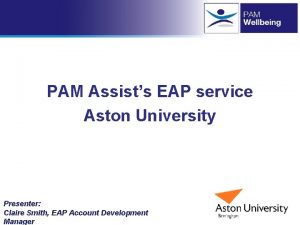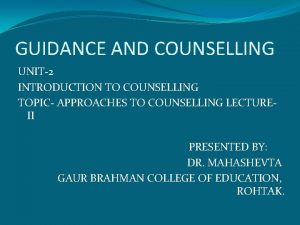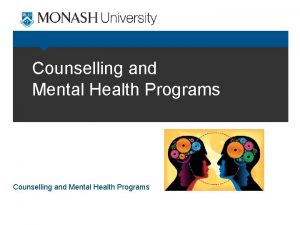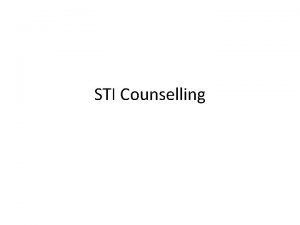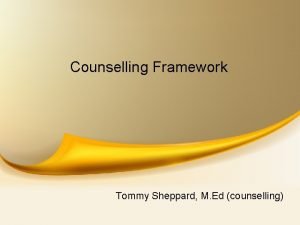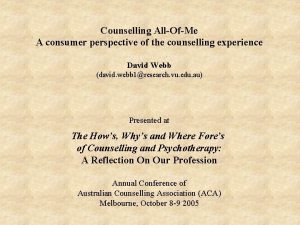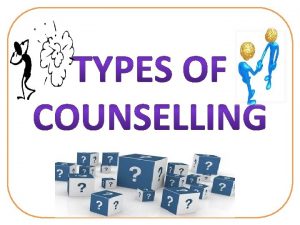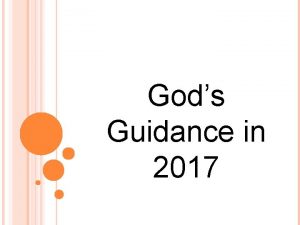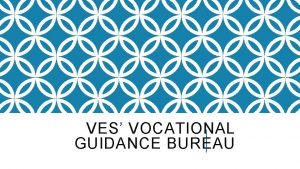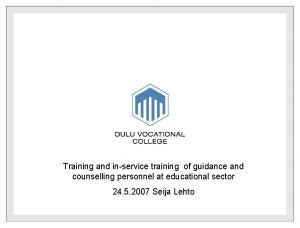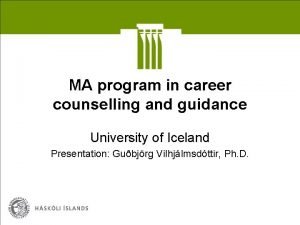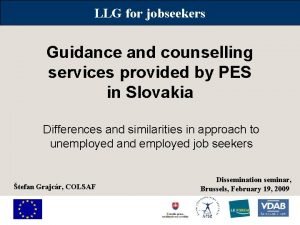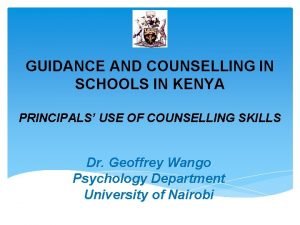GUIDANCE AND COUNSELLING Shycil mathew 1 920201 8





























































































- Slides: 93

GUIDANCE AND COUNSELLING Shycil mathew 1 9/20/201 8

v. Learning objectives : at the end of the class the students will be able to : define guidance and counseling discuss the purposes and needs enlist the basic principles of guidance and counseling list the types and approaches of guidance and counseling explain the counseling process , tools and techniques describe the role and preparation of counselor 2 9/20/201 8

Conti… discuss the organization of counseling services in nursing institutions enlist the issues for counseling in nursing students explain the management of crisis and referral 3 9/20/201 8

INTRODUCTION � Guidance & counselling are twin concepts & have emerged as essential elements of every educational activity. �Guidance & counselling are not synonymous term. Counselling is a part of guidance. � Guidance, in educational context, means to indicate, point out, show the way, lead out & direct. 4 9/20/201 8

Conti…. Counseling is a specialized service of guidance. It is the process of helping individuals learn more about themselves & their present & possible future situations to make a substantial contribution to the society. 5 9/20/201 8

DEFINITION OF GUIDANCE � Guidance is an assistance made available by a competent counselor to an individual of any age to help him direct his own life, develop his own point of view, make his own decision & carry his own burden. - Hamrin & Erikson � Guidance is a process of helping every individual, through his own effort to discover & develop his potentialities for his personal happiness & social usefulness. - Ruth Strang 6 9/20/201 8

DEFINITION OF COUNSELLING �Counseling is essentially a process in which the counselor assists the counselee to make interpretations of facts relating to a choice, plan or adjustment which he needs to make. - Glenn F. Smith �Counseling is a series of direct contacts with the individual which aims to offer him assistance in changing his attitude & behaviors. - Carl Rogers 7 9/20/201 8

DIFFERENCE BETWEEN GUIDANCE AND COUNSELLING GUIDANCE Guidance is broader & comprehensive Guidance is more external, helps a person understand alternative solutions available to him & makes him understand his personality & choose the right solution. Guidance is mainly preventive & 8 COUNSELLING Counselling is in-depth & narrow Counselling helps people understand themselves & is an inward analysis. Alternative solutions are proposed to help understand the problem at hand. Counselling is remedial as well as preventive & 9/20/201 8

DIFFERENCE BETWEEN GUIDANCE AND COUNSELLING GUIDANCE COUNSELLING Intellectual attitudes are Emotional rather than the raw material of pure intellectual attitude guidance are raw material of the counselling process. Decision making is Counselling operates at operable at an an emotional level intellectual level in guidance Guidance is generally Counselling is mostly education & career related offered for personal & & may also be for social issues. personal problems 9 9/20/201 3 8

PURPOSES OF GUIDANCE AND COUNSELLING • Providing the needed information & assistance • Helping in individual to make wise choices • Improve the understanding of self • Facilitate the adjustment • Helps in adapting to the changes or new environment • Making self-sufficient & independent 10 1 0 9/20/201 8

PURPOSES OF GUIDANCE AND COUNSELLING • Efficient use of capabilities & talent • Promote the optimal personal & professional development • Balanced physical, psychological, emotional, social & spiritual growth • Helps in overall development & to live productive life 11 1 1 9/20/201 8

Other functions of guidance and counselling… � To provide optimum development & well-being for individual. �To help individuals adjust to themselves & the society. � To help people understand themselves in relation to the world. �To aid individuals in efficient decision making. �. 12 1 2 9/20/201 8

Conti…. ØTo help individuals plan for a productive life in their social context by focusing on their assets, skills, strengths & possibilities for further development. � To bring about changes in the attitude & behavior of individuals 13 9/20/201 8

CHARACTERISTICS OF GUIDANCE It is process It is a continuous process Choice & problem points are the distinctive concerns of guidance It is the assistance to the individual in the process of development rather than a direction of that development Guidance is a service meant for all Guidance is both generalized & a specialized 14 9/20/201 8

Count… Guidance is an organized service & not an incidental activity of the school. Guidance is not a branch of any discipline Guidance bas limits Guidance is more an art than science Guidance bas its roots in the education system Guidance is centered around the needs & aspirations of students. 15 9/20/201 8

CHARACTERISTS OF COUNSELLING Counselling involves two individuals-one seeking help & the other a professionally trained person who can help the first. There should be a relationship of mutual respect between the two individuals. Counselling is aimed at bringing about desired changes in the individual for self-realisation & providing assistance to solve problems through an intimate personal relationship. 16 9/20/201 8

Conti. . v. The counselor discovers the problems of the counselee & help him to set up realistic goals v. If counselee is a student, counselling helps him to take a decision, make a choice or find a direction in matters related to an educational programme or career. v. It helps the counselee acquire independence & develop a sense of responsibility. It is more than advice giving. 17 9/20/201 8

Conti… It involves something more than offering an assistance to find a solution to an immediate problems. Counselling is democratic. Counselling concerns itself with attitudes as well as actions Counselling is centered around the needs & aspirations of students 18 9/20/201 8

SCOPE OF GUIDANCE AND COUNSELLING Guidance & counselling for personal needs/problems Guidance & counselling for educational needs/problems Guidance & counselling for physical, emotional, social, moral & marital problems Guidance & counselling for vocational, occupational & professional needs Guidance & counselling for career advancement 14 19 9/20/201 Guidance popr. tcoomble 9 m / 20 s / 2013 Guidance&&counsellingwwfwod. for rarjsyeitshholistic upaattdiiaobr. nolagslindividual 8

NEED OF GUIDANCE AND COUNSELLING I. Need s for personal & social domain Personal & social development of individual To adapt in different stages of development Offering art of better living Proper use of leisure time Holistic personality development Best use of available opportunities Motivates for effective utilization & development of self 20 9/20/201 8

NEED OF GUIDANCE AND COUNSELLING II. Needs for educational/professional domain Helps in academic growth & development Helps in vocational & professional maturity Facilitates an individual in the right education & profession Offer help to handle educational & professional situations Helps in the proper utilization of human resources Helps in adapting to the changing concept of education 21 9/20/201 8

Conti… Prepares to adapt in changing professional situations & emerging challenges Helps in making proper career choice Helps to minimize indiscipline 22 9/20/201 8

Need of Guidance and Counselling in Nursing Education… To help students adjusting with the new environment of the nursing institute. To help in developing qualities required for a successful for a nursing practice. To help students in getting adjusted with the clinical environment. To help students keeping in touch with the latest trends in nursing 23 9/20/201 8

Conti… To help students in developing positive learning habits, especially skill learning To help in the development of appropriate coping straggles in order to deal with stress in a productive manner 24 9/20/201 8

Need of Guidance and Counselling in Nursing Education… To help nursing students in establishing proper identity. To help them to develop a positive attitude towards life. To help to overcome periods of turmoil & confusion. To help students in developing their leadership qualities. To motivate them for taking membership in professional organizations after competing their studies. 25 9/20/201 8

Conti… Helps them to make advantages of technological advancement in a patient care. Helps them to readiness for changes & face challenges To carryout responsibilities as a health team member Helps them to proper selection of career Motivate them for higher studies. 26 9/20/201 8

FUNCTIONS OF GUIDANCE AND COUNSELLLING Adjustmental Developmental 27 Orientation 9/20/201 8

PRINCIPLES OF GUIDANCE According to Crow and Crow: All-round development of individuals Principles of individual differences Guidance is related to every aspect of life Cooperating among persons Guidance is a continuous & lifelong process Guidance for all Principles of elaboration Responsibility of teachers & parents Flexibility Principles of evaluation Guidance by a trained person 28 Principle of periodic appraisal 9/20/201 8

TYPES/AREAS OF GUIDANCE SERVICES Avocation al guidance Health guidanc e 29 Person al guidanc e Types of Guidanc e Services Vocation al guidanc e Social guidanc e Education a l guidance 9/20/201 8

Principles of counseling §Acceptance §Permissiveness §Respect §Thinking §Learning §Democracy 30 9/20/201 8

TYPES OF COUNSELLING APPROACHES Directive counsellin g approach 31 Nondirectiv e counselling approach Eclectic counsellin g approach 9/20/201 8

I. Directive Counselling Approach � It is also known as prescriptive counselling or counsellor-centred approach of counselling. � This approach of counselling is advocated by E. G. Williamson, a professor at University of Minnesota. �In directive counselling, the counsellor plays a leading role & uses a variety of techniques to suggest appropriate solutions to the counselee's problem. � 32 9/20/201 8

v. This approach also known as authoritarian or psychoanalytic approach. � The counsellor is active & help individuals in making decisions & finding solution to their problems. �The counsellor believes in the limited capacity of the patient. 33 9/20/201 8

I. Directive Counselling Approach Count… � The patient makes the decision but the counsellor does all he can to get the patient make decision keeping with his diagnosis. � The counsellor tries to direct the patient’s thinking by informing, explaining, interpreting & advising. � The basic assumptions related to directive counselling best approach: Problem Used for A needbased approac h 34 focused rather than patient focused approac h patients incapabl e of solving their problem s Task of a competen t counsello r 9/20/201 8 possible Making the use of counselee' s intellectual abilities & resources

I. Directive Counselling Approach Count… Steps of the directive counselling approach � E. G. Williamson has given the following six steps in providing directive counselling 35 9/20/201 8

I. Directive Counselling Approach Count… Advantages of the directive counselling approach �This approach save time. � It emphasizes the problem � It lays more emphasis on the intellectual rather than the emotional aspects of an individual’s personality. 36 9/20/201 8

I. Directive Counselling Approach Count… Limitations of the directive counselling approach � The patient does not gain any liability for self analysis or solve new problems of adjustment by counselling. �It makes the counselee overdependent on the counsellor. � Sometimes the counselee lacks information regarding the counselee, leads wrong counselling. � It does not guarantee that the counselee will able to solve the same problem on his own in future. 37 9/20/201 8

II. Nondirective Counselling Approach �The chief exponent of this counselling approach, Carp R. � It is also known as the permissive counselling approach where the counselor's role is passive & the counselee’s role is active. � It is a counselee-centred or patient-centred humanistic approach. 38 9/20/201 8

Conti. . � The counselee makes the final decisions as individuals are thoughts to have full right to make final decisions for the self & solve their problems. � The counsellor has to accept the counselee’s capacity to make adjustment & adapt. 39 9/20/201 8

II. Nondirective Counselling Approach count… � The principles of acceptance & tolerance are extremely important in this approach. � The basic assumptions related to nondirective counselling approach are: Patient is given importance than the counselling directions & investigations Emotional aspects are more significant than intellectual aspects. Creation of an atmosphere where patients can work out their understanding is more important than cultivating self- understanding in the patient. Counselling leads to a voluntary choice of goals & a conscious selection of courses of action. 9/20/201 40 8

II. Nondirective Counselling Approach count… Steps of the nondirective counselling approach � Carp R. Rogers given five steps in nondirective counselling: Defining the problem situation Termination of counselling 41 Counselee given freedom to express his feeling 9/20/201 8

II. Nondirective Counselling Approach count… Advantages of nondirective counselling approach It is a slow but sure process to make an individual capable of making adjustments. It removes emotional block & helps an individual bring thoughts on a conscious level thereby reducing tension. 42 9/20/201 8

II. Nondirective Counselling Approach count… Limitations of nondirective counselling approach It is a slow & time-consuming process. One cannot rely upon one’s resources, judgment & wisdom as the patient is immature in making the decision himself. It depends too much on the ability & initiative of the patient. 43 9/20/201 8

III. Eclectic Counselling Approach � This approach is based on the fact that all individuals are different from one another. � The techniques are elective in nature because they have been derived from all sources of counselling. � This approach is based on selecting the best & leaving out what is least required. � The patient is active & the counsellor remains passive in the beginning. 44 9/20/201 8

III. Eclectic Counselling Approach count… It is a synthesis of directive & nondirective counselling methods. Problem is solved jointly by counselor and counselee 45 9/20/201 8

III. Eclectic Counselling Approach count… Steps of the eclectic counselling approach Follow - up Establishing rapport Diagnosis the problem Counsellin g 46 behavior Analyzin g the case Preparing a tentative plan for modifying 9/20/201 8

III. Eclectic Counselling Approach count… Advantages of eclectic counselling approach It is more cost effective & practical approach. It is a more flexible approach of counselling. It is more objective & coordinated approach of counselling. Limitations of eclectic counselling approach The role of counsellor & the counselee are not predetermined. It requires more skilled counselors to handle the dynamic feature of this counselling approach. 47 9/20/201 8

IV. Other types of counselling A) Based on length of the counselling session: • Short-term counselling • Long-term counselling B) Based on number of counselees involved: 48 • Individual counselling 9/20/201 8

IV. Other types of counselling count… C) Counselling for educational & professional purposes: Student counselling Educational counselling Vocational counselling Career 49 counselling 9/20/201 8

IV. Other types of counselling count… D) Counselling for health-related purposes: Psychotherapeu tic counselling Crisis counsellin g Health counsellin g Genetic counsellin g E) Counselling for personal/social purposes: Personal counsellin g 50 Marriage counsellin g Motivationa l counselling 9/20/201 8 Development al counselling

PREPARATION OF COUNSELLOR Components of preparation of counsellor: Experience (at least 2 years of counselling experience, 3 -6 months of supervised counselling experiences) Educational Background (master’s or bachelor’s degree in teaching & education with training in behavioral science ) Personal fitness & attributes (should show positive interest in working with others) 51 9/20/201 8

Qualities of a Good Counsellor… G – Good technical knowledge O – Obtaining appropriate information from the patient O – Objectively answering questions D– Demonstrating 52 C – Confidentiality maintenance O – Observant U – Unbiased N – Nonjudgmental S – Sensitive to the needs of the patient E – Empathetic L – Listens carefully L – Lets the patient make decisions O – Open minded R – Respects the rights of the patients 9/20/201 8

Characteristics or qualities of counsellor… Interperson al relationship s: Friendly nature Sympathetic understandi ng Sincerity Tactfulness Patience Ability to maintain confidentiality 53 Attentive listener Personal adjustmen t: Maintain emotion al stability Emotionally sound & healthy Able to accept criticism Knowledge of self Scholastic potentialitie s: Relevant knowledge Motivated & committed Aware of policies, beliefs, misconception & rumors in community Possess common 9/20/201 8 sense

Characteristics or qualities of counsellor… Health & Leadership skills: personal Ability to stimulate appearance: Reinforce Pleasing voice important & appearance information Vitality & Direct the endurance counselee to ways Free from to solve the any Professional dedication: problem Show enthusiasm mannerism Maintain helping relationship Have a nice sense of 54 morality Philosophy of life: Good characte r Integrated personalit y Faith in human values 9/20/201 8

ROLE OF THE COUNSELLOR � Arrange orientation programmes for the other support staff to enlist their cooperation. � Prepare an up-to-date list of resources, information, referral & energy available to him. � Organize the guidance committee. � Set up an educational & occupational information centre. 55 9/20/201 8

Conti…. Display the information collected in an attractive way. � Disseminate information through educational & career talks, group discussion & so on. � Arrange talks by expert from different fields. � Organize career days, career weeks, career conferences, parents day & so on. 56 9/20/201 8

Count… � Educate students regarding proper study habits & assist them in their development. � Arrange individual discussion with students & their parents for giving them educational & occupational information. � Arrange visits to place of work like industries, business, establishments, offices, higher education institutions & other important educational places. � 57 9/20/201 8

Conti…. Maintain an active relationship with schools, colleges, universities. � Maintain an active liaison with club like Lions Club & Rotary Club. � Refer serious mental cases to clinical psychologist or psychiatrists. 58 9/20/201 8

Count… �Maintain complete secrecy of the discussion between him & the patient. �Administer psychological tests. �Provide counselling services to students. �Help in the student placements. �Take up research projecting relating to the fields of educational, vocational, personal & social guidance in colleges. 59 9/20/201 8

COUNSELLING PROCESS Phase I Establishing relationship Phase II Assessme nt Phase III Setting goals 60 Phase I V interventio 9/20/201 8

Phase I: Establishing relationship �It is an ice breaking session during which the counsellor & counselee introduce each other & establish a primary rapport. �Good rapport building provides the respect, trust & sense of psychological comfort to the counsellor- counselee relationship for progression to the counselling process. �Strategies to establish an effective relationship: o Introduce yourself o Being the phase with adequate social skills o Always address the individual by his or her 61 9/20/201 name 8

Count… o o Ensure physical comfort of the counselee & self. Do not interrupt the individual when he/she is talking. Listen attentively. Observe nonverbal communication. 62 9/20/201 8

Phase II: assessment � The second phase of counselling is basically a data collection phase, where the counsellor motivates the counselee to provide complete information about the problem. � The type of information collected from counselee like general data, physical data, psychological data, social/environmental data, achievement data, educational & vocational data. � 63 9/20/201 8

Conti… v. After the collection of information, diagnosis related to the counselee’s behavior is made. � Various tools & techniques used for data collection like intelligence tests, achievement tests, aptitude tests, interest tests, personality tests, questionnaires, interview, observation, autobiography, anecdotal records, rating scale, cumulative record and case studies. 64 9/20/201 8

Phase III: Setting goals � During this third phase of the counselling process, goals are set co-operative by both the counsellor & the counselee. � While setting goals, the counselee’s strengths, weakness, constraints & available resources must be kept under consideration. � The goal could be immediate & ultimate which directs the counsellor & the counselee to further progress in the counselling process. � Effective & reliable goal setting requires following skills in counselors: Multifaceted knowledge related to the problem of 65 9/20/201 counselee 8

Count… Ability to think critically & inference-drawing skills. Judgment, planning & management skills Skills to segregate &differentiate the provided information Ability to each individuals to think critically & realistically Help the counselee set feasible, reliable & achievable goals 66 9/20/201 8

Phase IV: Intervention � This stage of counselling is an operational phase where the counselee is suggested the best possible options for the management of the present problem. � The phase is affected by the counselor's own thoughts about the counselling process. � The intervention will depend on the approach used by the counsellor, the problem & the individual. � The choice of intervention is a process of adaptation & the counsellor should be prepared to 67 change the intervention when the selected 9/20/201 8

Phase V: Termination and follow-up �This is the final stage of the counselling process, where counselling comes to an end. �Termination must be planned well ahead so that the counselee may feel comfortable at the departure & gradually able to handle the problem independently. �Some follow-up sessions may be required to help the counselee further to handle the problem independently. 68 9/20/201 8

TOOLS AND TECHNIQUES FOR THE COUNSELLING PROCESS There are two types of tools & techniques for the counselling process: 69 9/20/201 8

Tools for counselling services… Nontesting tools Anecdotal record I. Interview It is an interaction between the counsellor & counselee with a definite objective in mind Observation It is careful watching or monitoring of the counselee by the counsellor with a specific objective in mind It consists of recording an important incident that happened & is a carefully recorded snapshot of the incident Checklist A is used to identify Rating Scale Cumulative record the presence or It is better tools to It is a method of absence of assess the degree recording specific attributes or or extent of the & providing meaningful, skills of a particular performance of a significant & expected behavior particular task or Autobiography & diary comprehensive in students. the possession of It is used to measure sociability or the [life sketch] information about an information about students. a trait. social distance between students or members 34 www. drjayeshpatidar. blogspot. com 9/20/201 70 over grou a year. of individual, a 8 9/20/2013

Tools for counselling services… II. Psychological tests Personality tests Eg; The Rorschach & The Minnesota Aptitude tests Eg; Specialize aptitude test & General aptitude test Interest inventory tests Eg; Blank and Kuder preference inventory 71 Achievement tests Study habit inventory tests Eg; The Eg; Cooperative test, College Board series, English reading test Brown- Holtzman survey of study habit 9/20/201 8

Standardized tools and techniques… Intelligenc e tests Personalit y tests Interes t tests 72 Standardize d tools & techniques Achieveme nt test Aptitude tests 9/20/201 8

Nonstandarized tests… Autobiography Anecdotal records Intervie w Case study 73 Observatio n Rating scale Information collection of information Questionnair e Cumulative record Sociometri c technique s 9/20/201 8

ORGANIZING GUIDENCE AND COUNSELING SERVICES 74 9/20/201 8

Count… Members of the counseling committee: � Administrator � principal/Dean � Counselling/Liaison officer � Deputy chief of counselling section � Counselling personnel/ Counselor � Vocational guidance officer � Teacher/Faculty from different department/ Specialties � Hostel warden/ Librarian � Students representatives � 75 Parents 9/20/201 8

• headed by qualified counselor assisted by one or two clerical staff §Along with one college faculty member §Faculty members are trained to provide nonspecialist services to the students §If any students needed special services the faculty referring him to the counselor § mentorship/teacher guardian program § 10 students /teacher §Class coordinator look after overall students 76 9/20/201 8

Conti…. . §Mentor should conduct periodic meeting with her assigned group of students §Fix next meeting for follow up §Fill Performa during first meeting §Filled Performa sent to counseling department through principal §When mentor feel that student need special services she need to report to principal , class coordinator and counselor §Counselor then take over the students §Giving adequate counseling and solving issues. 77 9/20/201 8

Conti… • Review will be conducted monthly under the chairmanship of the principal • In this meeting present report by mentor , class coordinator , and counselor 78 9/20/201 8

ISSUES OF COUNSELLING IN NURSING Scarcity of qualified & competent counselors Lack of awareness about needs & resources of counselling Minimal procounselling environment Lack of counselling training for nurse/nursing faculty Poor organizational set-up for counselling services Lack of interest & initiatives for counselling services counsellor burnout , -counselee ratio Lack of funds for counselling services 79 Poor physical facilities 9/20/201 8

MANAGING DISCIPLINARY PROBLEMS � Common disciplinary problems seen in Indian students are Absenteeism, Nonsubmission or late submission of assignments, Disturbing classroom atmosphere, Threatening strike, Damaging or spoiling institutional property, Picking quarrels over small matters, Using mobiles phones in the classroom & so on. 80 9/20/201 8

Conti…. v. Gossiping , sleeping in class room v. Arrogant behavior with teachers and friends v. Cheating in class tests and exams v. Violating library rules v. Disturbing other students v. Coming late to the class room. 81 9/20/201 8

Strategies for management of disciplinary problems… • Appropriate training of faculty & teachers • Adequate practice of cocurricular & extracurricular activities • Appropriate selection & use of disciplinary standards • Use reward & punishment • Promoting better teacher-student relationship • Cultivation of ethical, moral & spiritual values • A close teacher-parent-student contact • Effective use of guidance & counselling programmes 82 9/20/201 8

DISCIPLINARY MANAGEMENT 1. Preventive disciplinary 2. Supportive/corrective disciplinary management 1. prevention in class room positive behavior management social skill instruction Campus wide prevention unified discipline approach 83 9/20/201 8

Conti. . 2. Supportive/corrective disciplinary management positive and negative reinforcement arrange disciplinary conferences administer disciplinary actions follow HOT STOVE RULES 84 9/20/201 8

CRIRIS Definition : crisis is a sudden in one’s life that disturbs homeostasis , during which the individual ‘s usual coping mechanisms cannot resolve the problem 85 9/20/201 8

Types Situational crisis eg. l oss of job Adventitious eg. flood, fire Maturational eg. identity crisis 86 9/20/201 8

MANAGEMENT OF CRISIS AND REFERRAL �A sudden, generally unanticipated event can profoundly & negatively affect a significant segment of the institution population & often involves serious injury or death. � Crisis events like an incidence of suicide, school bus crashes, natural disasters or multiple injuries, deaths can quickly escalate all over the educational institution. � Crisis must be managed promptly & skillfully to minimize chaos, rumors & impact of the crisis on the victims & other students. 87 9/20/201 8

Stages of Crisis Intervention A number of crisis intervention models have been developed. The model proposed by Golan (1978) involves three stages: ASSESSMENT (Session 1) The assessment stage of crisis intervention entails: 1. Identifying the precipitating factor ("what happened? "); 2. Determining the client's subjective reactions to the precipitating factor ("how did you respond? "); 88 9/20/201 8

Conti… 3. Defining the context of the crisis situation including the hazardous event ("can you remember what started this? "); 4. Assessing the client's present state ("what is happening now? "); 5. Precisely defining, in conjunction with the client, the current problem ("we agree that the most important problem is your anxiety about getting along without your husband"). 89 9/20/201 8

IMPLEMENTATION The implementation phase involves obtaining relevant background information (e. g. , information on the client's pre-crisis functioning, previously used coping strategies, the client's strengths and weaknesses, and available resources and support systems), setting immediate goals, and identifying tasks that allow the client to achieve those g 90 9/20/201 8

TERMINATION During the termination phase, the client and therapist review the client's progress in terms of the goals of the intervention, arrive at a decision to terminate, and discuss the client's plans for the future and plan follow up 91 9/20/201 8

Techniques of crisis intervention v. Catharsis v. Clarification v. Suggestion v. Reinforcement of behavior v. Support of defenses v. Raising self esteem v. Exploration of solutions 92 9/20/201 8

93 9/20/201 8
 Difference between counseling and advice
Difference between counseling and advice Difference between counselling and guidance
Difference between counselling and guidance Objectives of counselling
Objectives of counselling Father of guidance and counseling in the philippines
Father of guidance and counseling in the philippines Asca vision statement examples
Asca vision statement examples Guidance counselling
Guidance counselling Ul guidance counselling
Ul guidance counselling Incisal guidance
Incisal guidance Example of indirect guidance
Example of indirect guidance Disquieted meaning
Disquieted meaning Jojy mathew
Jojy mathew Maniobra de yódice-sanmartino
Maniobra de yódice-sanmartino Matthew 10:12
Matthew 10:12 Mathews v eldridge test
Mathews v eldridge test Astra greek hacker
Astra greek hacker Pediatrician job descriptions
Pediatrician job descriptions Mathew 24:44
Mathew 24:44 Mathew 6:9
Mathew 6:9 Propulsive phase of labour
Propulsive phase of labour Matthew 5:30
Matthew 5:30 Jose manuel mathew
Jose manuel mathew Asher mathew
Asher mathew Mathew williams md
Mathew williams md Mathew 2
Mathew 2 Matthew 8:3
Matthew 8:3 Matthew 7:28
Matthew 7:28 Matthew 12:36-37
Matthew 12:36-37 Working principle of gi-fi technology
Working principle of gi-fi technology Bessie mathew
Bessie mathew Ee5358
Ee5358 Brandt andrews method
Brandt andrews method Modified brandt andrews method
Modified brandt andrews method Mathew 17:1-8
Mathew 17:1-8 Propchain crypto
Propchain crypto Mathew zaleski
Mathew zaleski Matthew 13
Matthew 13 Mathew 6:9
Mathew 6:9 Matthew 23 esv
Matthew 23 esv Xxxx ccom
Xxxx ccom Escultor benjamin victor
Escultor benjamin victor Mathew pletcher
Mathew pletcher Being a good steward quotes
Being a good steward quotes Mathew pereira
Mathew pereira Matthew 8 nkjv
Matthew 8 nkjv Matthew 28:19-20
Matthew 28:19-20 Matthew 5:1-12 nkjv
Matthew 5:1-12 nkjv Matthew 28 19-20
Matthew 28 19-20 Mathew 26:36-44
Mathew 26:36-44 Matthew last supper
Matthew last supper Matthew 21:18 - 22:14
Matthew 21:18 - 22:14 Mk mathew
Mk mathew Mk mathew
Mk mathew Fs71i
Fs71i Ephesians 6 10-13 kjv
Ephesians 6 10-13 kjv Robert stevenson mary poppins
Robert stevenson mary poppins Tisson mathew
Tisson mathew Structure of dover beach
Structure of dover beach Difference between health education and promotion
Difference between health education and promotion Black and asian counselling network
Black and asian counselling network Health education and propaganda
Health education and propaganda Counselling psychology doctorate
Counselling psychology doctorate Counselling action plan
Counselling action plan Lse nnn
Lse nnn Cormier and hackney
Cormier and hackney Explain performance counselling
Explain performance counselling Merchant bankers
Merchant bankers Project counselling in merchant banking
Project counselling in merchant banking Summarizing in counseling
Summarizing in counseling Paraphrasing in counselling
Paraphrasing in counselling Scopes of counseling
Scopes of counseling Counselling définition oms
Counselling définition oms Gather family planning
Gather family planning Counselling définition oms
Counselling définition oms Gather acronym in counselling
Gather acronym in counselling Concepts of counselling
Concepts of counselling Redi in counselling
Redi in counselling Barbara douglas counselling psychologist
Barbara douglas counselling psychologist Shane harrison and esther beckley
Shane harrison and esther beckley Carrs lane counselling
Carrs lane counselling Care first counselling
Care first counselling Neunkirchen counselling
Neunkirchen counselling Group therapy stages of development
Group therapy stages of development What is bracketing in counseling
What is bracketing in counseling Uq student services counselling
Uq student services counselling Patient counselling for peptic ulcer disease
Patient counselling for peptic ulcer disease Ethics in counselling
Ethics in counselling Credit counselling owen sound
Credit counselling owen sound What is counselling
What is counselling What is counselling
What is counselling Safety counseling
Safety counseling Safety counseling
Safety counseling Principles of guidance
Principles of guidance Family planning counselling
Family planning counselling Pam assist contact number
Pam assist contact number
